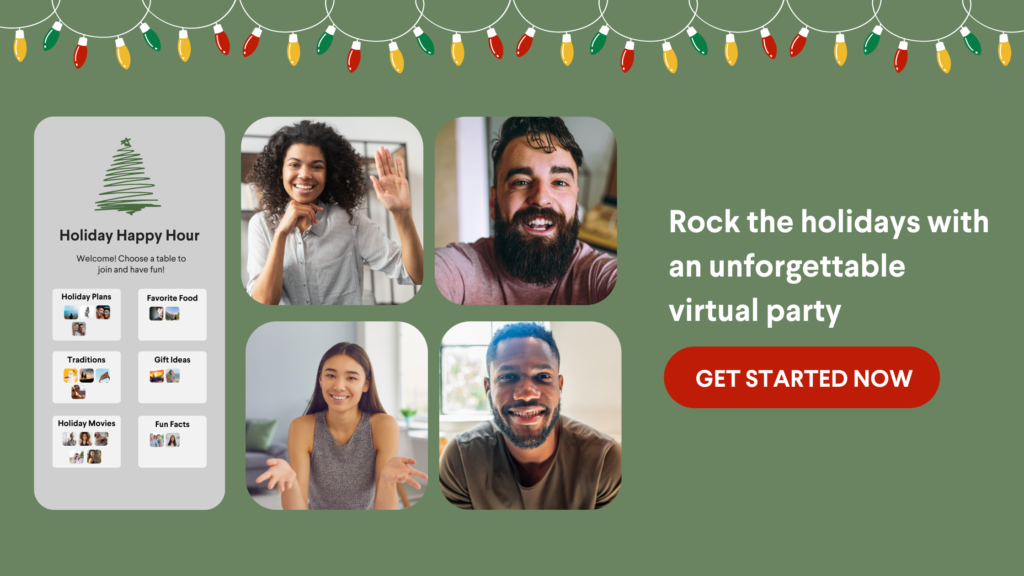If your company is planning a holiday party this year, one of the first questions you will face is whether to host it online or as a traditional in-person celebration. But why not offer both in one experience?
That’s right, we’re talking about a hybrid workplace holiday party. The ultimate way to provide your team total autonomy in how they celebrate the holiday season with their colleagues, either online or in-person.
A hybrid holiday party could be a great choice for your team, but there are unique hurdles and considerations involved when planning any sort of hybrid gathering.
To help expedite your holiday party planning, let’s explore if a hybrid holiday party is right for your team and our tips for hosting a hybrid party will delight everyone.
How To Decide If You Should Host a Hybrid Holiday Party
What is the true purpose of a company holiday party? To celebrate your team, of course.
Your team members and their preferences should be top-of-mind throughout every step of your holiday party planning. A hybrid party could give them the much-needed freedom of choice for how to engage in the festivities. This is even more important if your company has a number of geographically dispersed locations that usually didn’t get to celebrate the end of the year together.
To understand if a hybrid holiday party is a good option for your team, we recommend you directly ask them. Gauge whether they are interested in a remote company holiday party, if they’d rather celebrate the season from the comfort of your office, or if they are flexible for either option. Also, check on their preferred activities during a holiday party in their preferred format.
Beyond your team preferences, the following considerations will also impact whether a hybrid holiday party is a good fit for your company. Of course, these questions are also valid when planning a virtual holiday party, but they are amplified in hybrid settings:
- How geographically dispersed is your team? You need to find a time that works for your whole team to meet, which could be difficult if your team spans multiple time zones.
- Will in-person attendees drop out on the day of? Unforeseen circumstances like extreme weather or individual team member needs could lead to last-minute cancellations for the in-person event.
- What is your holiday party budget? Virtual parties can be more affordable than an in-person equivalent, especially if your team is known to host extravagant parties at exclusive (and expensive to book) locations.

3 Tips for Hosting a Hybrid Holiday Party for Work
If your team decides that a hybrid holiday party will best fulfill everyone’s needs and work within your budget, there are a few planning considerations to be aware of.
First, familiarize yourself with the steps for planning an engaging virtual holiday party, which we detailed recently on the blog. Then, follow these best practices to ensure you plan a hybrid party that creates a cohesive and fun experience for everyone.
Create a Seamless In-Person and Virtual Experience
The worst way to plan a hybrid party is to prioritize the in-person experience and simply add an option for people to stream the experience—leaving them to sit and stare at their screen as the in-person guests mix and mingle.
Everyone at your holiday party should have the same activities and opportunities, regardless of how they choose to join. This starts with your lineup of activities, and we share 10 workplace holiday party games great for a virtual or hybrid holiday party.
Further build this sense of cohesion by replicating your in-person experiences for an online setting. If you plan to serve food and drink at your party, mail your virtual guests gift cards to acquire their own snacks. Or, send them goodies beforehand. If you have a photo booth at your event, consider creating custom webcam backgrounds to replicate a photo booth experience for your virtual guests.
Designate a Delegate for Virtual Guests
For your hybrid holiday party to work, you need at least one on-site team member dedicated to engaging with the virtual attendees and ensuring they feel part of the experience. This person can monitor for messages from the remote attendees, help them overcome any communication difficulties, and grab the attention of the in-person group when needed.
The delegate will also be vital in helping orchestrate any of the games or activities you choose to participate in.
Create Breakout Spaces to Mingle
At a traditional in-person holiday party, your team members often flock to small group conversations that they casually hop in and out of at their leisure. At a hybrid party, you do not want your in-person attendees to completely ignore your virtual guests.
In your virtual event platform, create breakout rooms with conversation prompts and others with room themes for your virtual attendees to join. Then, set up a few laptops and webcams throughout your event space for the in-person guests to come up to, chat with the virtual guests, and move through the computers over the course of the event. Again, your virtual guest delegate will be helpful to encourage the in-person guests to engage with the virtual attendees.
Hybrid Event Technology Enables Fulfilling Holiday Parties
We expect many teams will explore hybrid workplace and personal celebrations this year, be it a hybrid Christmas party, Kwanzaa celebration, or general holiday shindig. These event planners will need to overcome an unfamiliar set of challenges, but the fact is that the future of work is hybrid. And the future of celebrations will likely be hybrid, too.
By hosting a hybrid holiday party, your team can learn how to best overcome the hurdles of these gatherings and build a foundation to plan all of your workplace gatherings in 2022.
One of the essential ways to enable a successful hybrid event is to invest in technology that was created with your team’s experience in mind. Frameable Events was built to enable genuine engagement, with the features and capabilities your team needs to host a successful workplace party.









